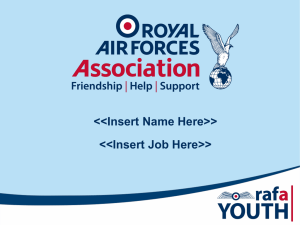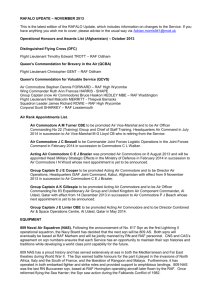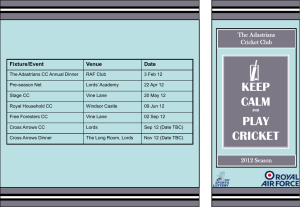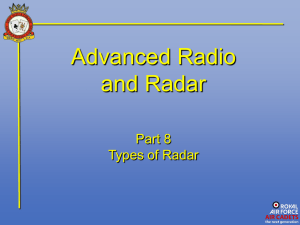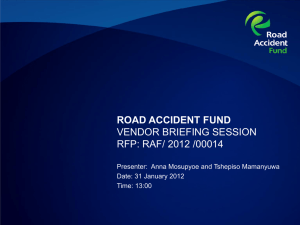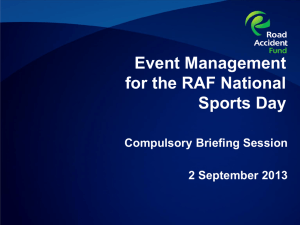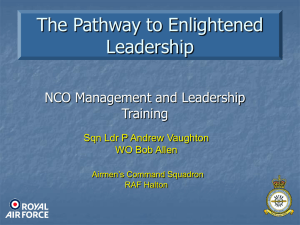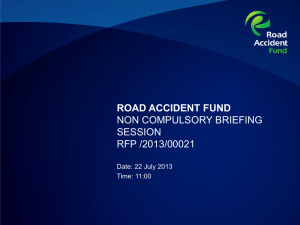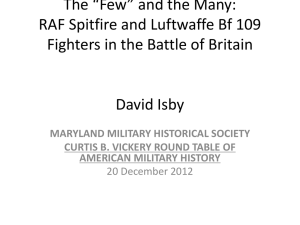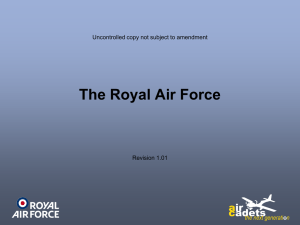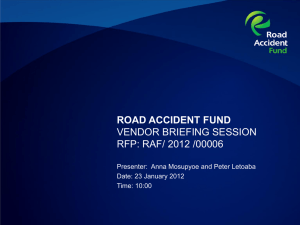THE ROYAL AIR FORCE
advertisement
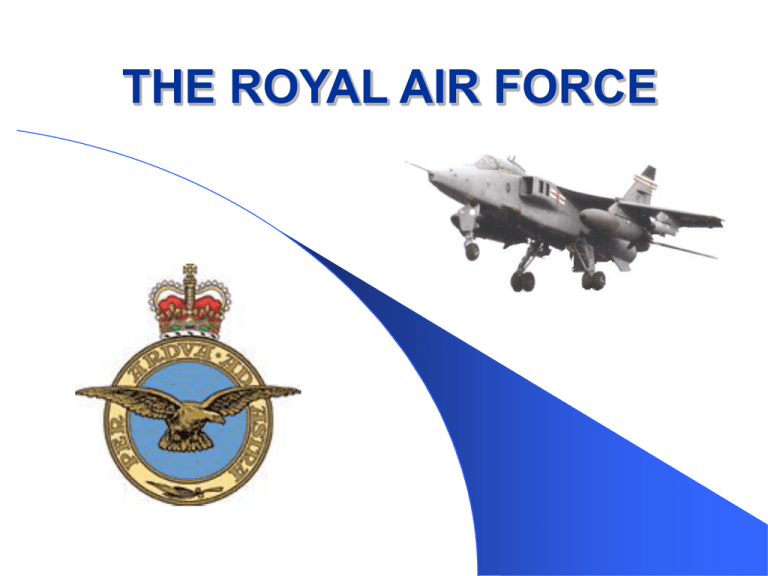
THE ROYAL AIR FORCE PART 2 ORGANISATION OF THE RAF The RAF, like the Navy & Army is loyal to the Crown but is controlled by Parliament. Defence Council The Prime Minister and the Cabinet hold supreme responsibility for national defence and they decide what policies the country should follow. They exercise control of the Armed Forces through the Defence Council. The Secretary of State for Defence, appointed by the PM, is Chairman of the Defence Council Air Force Board Each of the 3 services is controlled by a board of senior officers: Admiralty Board – RN Army Board – BA Air Force Board – RAF The Heads of these Service Boards are members of the Defence Council where they advise the Government on matters affecting their own service. The Air Force Board controls the Royal Air Force. Each member of the AFB is a senior officer or civil servant heading a specialist branch concerned with a particularly section of the RAF’s work; all the different Branches added together are called: “The Air Force Department” of the Ministry of Defence (MOD) RAF Command Structure Outside the MOD the directives of the Air Force Department are put into effect by: RAF Commands Grouped into 2 Commands, determined by the jobs they do: • Strike Command. • Personnel & Training Command. RAF Groups Sub Headquarters called Groups to control specialist units – e.g. those flying a particular class of aircraft such as fighters. Only exist in Strike Command. P&T Command controls its Units directly. RAF Units & Stations “Unit” is the title applied to elements of the RAF which are established to cover a particular function, e.g. Maintenance Unit, Signals Unit. • The Basic Operational Unit is a Squadron. • Squadrons are equipped with aircraft or missiles or they may be squadrons of the RAF Regiment. • According to their size & role, squadrons may be sub divided into two or more flights. • The location of an individual unit or number of units is known as a RAF Station. • An RAF Station is run by specially trained staff, who themselves are arranged in squadrons. Framework of the RAF DEFENCE COUNCIL CHIEF of AIR STAFF AIR FORCE BOARD STRIKE COMMAND PERSONNEL & TRAINING COMMAND UNITS No. 1 GROUP No. 2 GROUP No. 3 GROUP UNITS UNITS UNITS OVERSEAS UNITS STRIKE COMMAND Strike Command is based at RAF High Wycombe where it controls all RAF Offensive & Defensive operations at home & overseas. Overseas units include: • Falkland Islands • Cyprus • Gibraltar • Ascension Island Groups No. 1 Group: • Responsible for all strike attack & offensive support aircraft. • Operates all the RAF’s front line fighter aircraft including, in the future, Eurofighter. • Seek & attack enemy targets on the ground. • Battlefield support forces – long range transport & tactical transport & short range offensive aircraft to support battlefield operations. No. 2 Group: • Operates all the aircraft & force elements that support front line operations. • Includes air transport & air to air refuelling aircraft • RAF Regiment & Ground Based Air Defence systems. (Defence Systems will now be controlled by the British Army). • RAF E3 Sentry – Air Defence. (RAF Waddington) No. 3 Group: • Home for the new Joint Force Harrier. (With RN). • Nimrod Maritime Patrol aircraft. • Search & rescue Helicopters. • RAF Mountain Rescue Teams. HQ Personnel & Training Command P&T Command was created on the 1st of April 1994 and embraces all aspects of: • Recruitment • Training • Career Management • Welfare • Conditions of Service • Pensions All RAF policy & implementation staffs involved in the full span of personnel functions are based at the Command’s headquarters at RAF Innsworth in Gloucester. RAF Units & Stations More than 1 unit can be located on an RAF Station. If the Units are mostly operational Squadrons, i.e. squadrons flying aircraft designed to perform an offensive, defensive or reconnaissance air role, the station is known as an operational station. Other stations can be either flying stations, e.g. stations housing Maintenance Units or Command/Group Headquarters etc. A typical station is organised into 3 wings: • Operations • Engineering • Administrative Structure of Station: Station Commander OC Engineering Wing OC Operations Wing Flying SQN’s Operations SQN’s M&E SQN AIR Air Traffic Control Electrical Eng Squadron Station Service Squadron OC Admin Wing M&E SQN GROUND Education & Training SQN Supply Squadron Supply Squadron Catering Squadron Personnel Management SQN Accounts Flight General Duties Flt Security & Police Catering Flight Estates Flight RAF Regt Flt PE Flight Medical Flight Personnel Services Flight Operations Wing Flying Squadrons Air Traffic Control Fire Services • Photographic Interpretation Engineering Wing • Electrical Engineering • Electronic Engineering • Armoury The Engineering Wing is responsible for the repair & maintenance of Air & Ground equipment. Mechanical Engineering Day to day repair & maintenance on operational aircraft. MT Section Housing & Services the vehicles needed to re-fuel, re-arm and ground handle the aircraft, as well as the other vehicles to support the Station’s domestic task. Admin Wing The Administrative Wing looks after the personnel who live & work on the Station. Through it’s specialist squadrons & flights, Admin Wing controls the day to day management of: Catering Accommodation Recreation Security Financial Medical BASE SECURITY! All RAF Bases have a high level of security measures to ensure prevention of attack by terrorism etc. As a cadet on an RAF Base or any other MOD site, you should do the following: • Always carry your 3822 (ID) at all times. • Behave in a sensible and cadet like manner. • Never enter buildings without permission. • Never touch military hardware/aircraft/equipment unless advised. • Report any suspicious/unidentified packages to the Guardroom. The Guardroom is manned 24 hours a day to ensure site security. Security is EVERBODY’S responsibility when on an RAF/MOD Base. RAF Ranks – (Non Commissioned) LAC – Leading Aircraftsman SAC – Senior Aircraftsman JT – Junior Technician CPL – Corporal (JNCO) SGT – Sergeant (SNCO) CT – Chief Technician (SNCO) F/SGT – Flight Sergeant (SNCO) WO – Warrant Officer (SNCO) Highest & Most Respected Rank (Non – commissioned). Aircrew Ranks SGT AC – Sergeant Aircrew (SNCO) F/SGT AC – Flight Sergeant Aircrew (SNCO) MAC – Master Aircrew (SNCO) ARE THERE ANY QUESTIONS?
